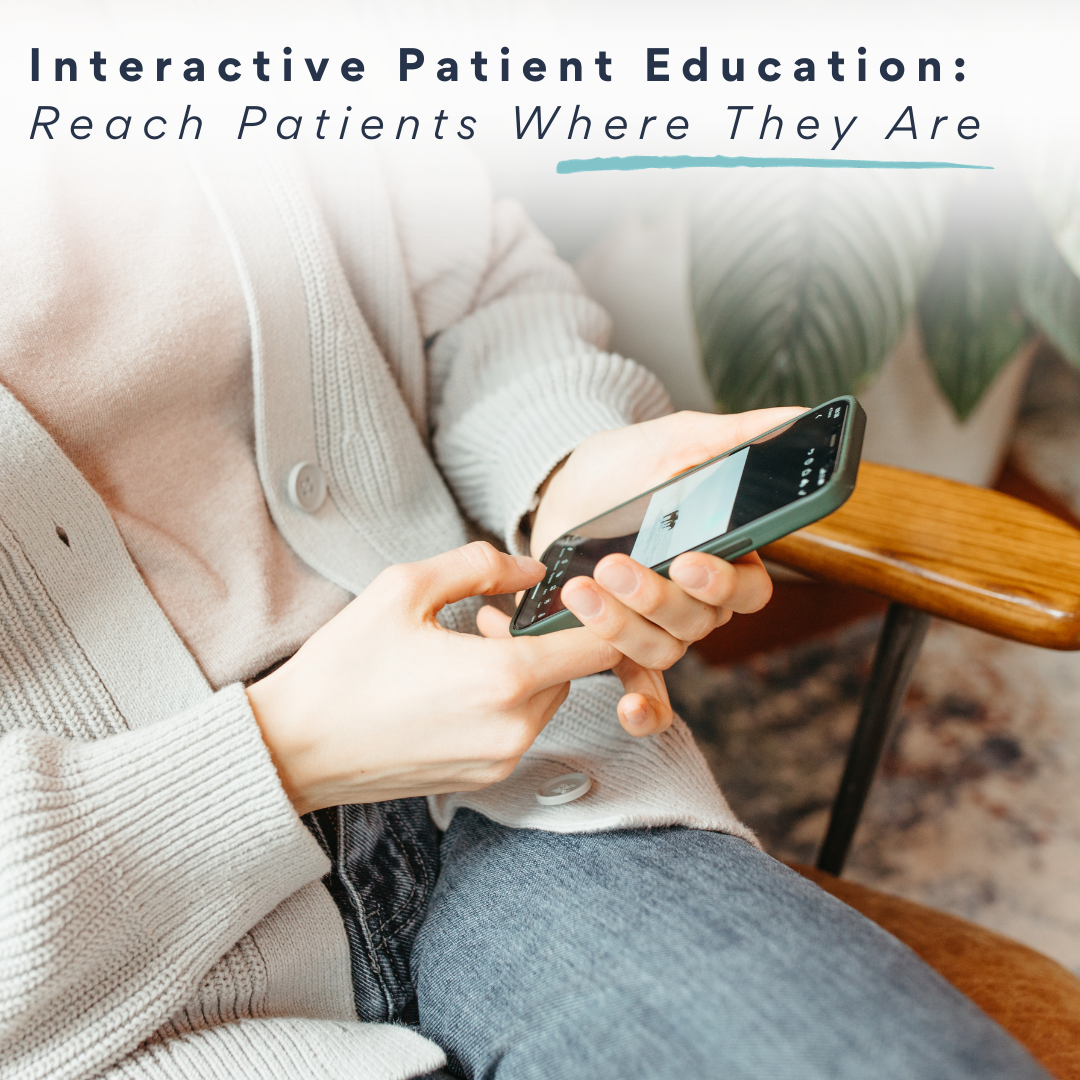Interactive Patient Education: Reach Patients Where They Are

As healthcare and technology continue to converge, communicating with patients is now increasingly taking place digitally. Whether it’s scheduling online, telemedicine visits or educating patients, the medical office is no longer the only venue for reaching patients. Which begs the question: how do we reach patients where they are?
One solution that has been gaining traction in the industry is “Interactive Patient Education” AKA digital programs and tools that allow patients to take charge of their health, with their provider’s guidance, in-between office visits.
As a healthcare professional, you understand that the ability to educate and empower patients can directly influence their health outcomes but if you’re struggling to give patients everything they need during your brief time with them, read on. In this article, we’ll delve into the uses of interactive patient education and explore how leveraging technology can significantly enhance the capacity to reach patients in ways that traditional methods, such as pamphlets, might fall short.
Interactive Patient Education
Before we discuss the advantages of interactive patient education, let’s explore what it is. Interactive patient education refers to hands-on digital methods to convey medical information to patients, such as videos, tasks and educational copy online. Rather than relying solely on static or passive materials like pamphlets or brochures, this approach leverages technology to create a more engaging and personalized learning experience.
This medium also allows patients to continuously access the same materials, rather than absorb information once and forget soon after.
In essence, interactive patient education is about meeting patients where they are – both in terms of understanding and remotely using technology. It acknowledges that the modern patient is accustomed to an interactive and digital world, so, the approach to patient education should reflect this reality.
The Power of Technology in Patient Education
Now, let’s explore how technology can be a game-changer in patient education, surpassing the limitations of traditional patient education:
1. Accessibility and Convenience:
In a world where information is at patients’ fingertips, the expectation is for healthcare to be readily accessible. Technology allows information to be provided that patients can access medical education from their provider at any time and from any location, catering to their busy schedules.
2. Customization and Personalization:
Every practice and practitioner is unique, and their methodology and medical advice will vary from practice to practice. Some pamphlets or materials that you provide to patients may not reflect your practice’s particular advice.
Interactive patient education platforms include customization features, allowing you to tailor the educational content to the specific needs and preferences for your patient population. These platforms and programs also include your practice logo, and your patients’ names, making it a much more personal experience. This personalization can foster a deeper connection between you, patients, and their healthcare journey.
3. Increased Information Retention:
Studies consistently show that interactive and multimedia content leads to higher information retention rates compared to traditional methods. The combination of visual, auditory, and interactive elements helps reinforce key concepts, ensuring that patients better understand and remember the information provided.
4. Real-time Feedback:
Unlike static materials, interactive patient education allows for real-time feedback and communication. Patients can ask questions, seek clarification, and provide input, fostering a collaborative and informed healthcare experience.
5. Trackable Progress:
Embracing the Future of Healthcare Education
Interactive patient education represents a leap forward, allowing connection with patients on a level that transcends the limitations of traditional methods.
Embracing interactive patient education is embracing the future. As healthcare professionals, it is your responsibility to speak the language of patients and guide them on a journey towards better health and understanding.
BodySite: Your Solution for Interactive Patient Education
BodySite provides you with all the tools you need for interactive patient education…
- Customizable and turnkey education programs for your patients
- White labeled platform with your branding
- Tracking functionality for food, activity and biometric data
- Task tracking inside of programs
- Available inside mobile app and desktop
- HIPAA-compliant
Try BodySite Free for 30 Days!
If you haven’t experienced the transformative power of BodySite, now is the perfect time to explore. We invite you to try BodySite free for 30 days and witness firsthand how our platform can elevate your patient education initiatives.
Test Drive Our Platform with No Obligation
Curious about how BodySite works? Take a test drive with our preview version – no credit card required. Explore the features, navigate the interface, and envision the positive impact on your patient education strategies.
Embark on a journey towards more effective and engaging patient education with BodySite. Join the ranks of healthcare professionals who have embraced a new era in healthcare communication. If you have any questions or need assistance, our dedicated support team is ready to guide you through every step of the way.
Your patients are ready to engage, learn, and take control of their health. BodySite is here to empower you in delivering the education they deserve. Try it today and redefine the way you educate and connect with your patients.
Sources:
- https://www.ncbi.nlm.nih.gov/pmc/articles/PMC7644889/ Abdulrahaman MD, Faruk N, Oloyede AA, Surajudeen-Bakinde NT, Olawoyin LA, Mejabi OV, Imam-Fulani YO, Fahm AO, Azeez AL. Multimedia tools in the teaching and learning processes: A systematic review. Heliyon. 2020 Nov 2;6(11):e05312. doi: 10.1016/j.heliyon.2020.e05312. PMID: 33195834; PMCID: PMC7644889.
- https://www.sciencedirect.com/science/article/pii/S2452301120300511

